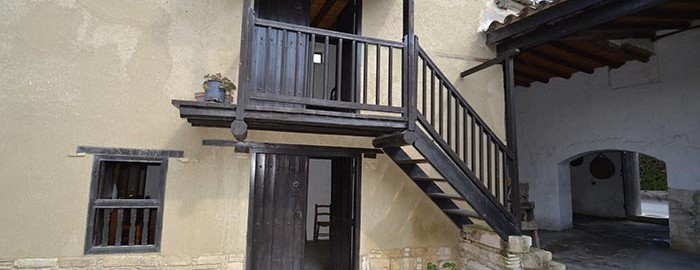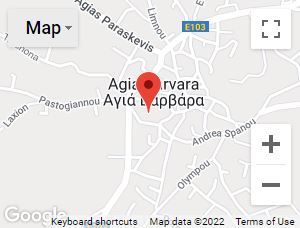
THE FIRST-INDUSTRIAL LABORATORY OF AGIA VARVARA
A person with creativity and his machine
Each place and each season have some persons that escape from time and geographic limits, set by their fate and they move more than others, opening some news ways. These therefore are simple persons with creativity that seek continuously an exit in the daily life.
Such a person was Mr. Gregoris Theocharous from Ayia Varvara of Nicosia, during the time that his villagers and compatriots were fighting to survive, found the way to make his own life and others, easier and productive.
This orphan boy, who has not finished the elementary school, managed with his stubbornness and his love for progress, to mechanize from the decade of 1920, the main rural occupations of his season. Perhaps his bigger pleasure was that god gave him a lot of years to live and see for a lot of decades the applications that he had begun in his village being applied by others.
Born in 1887 and having lost his father at the age of 5, “Mastre Glioris”, as he was rightfully called and known, he went abroad to Egypt at the age of 13. The chances for him were not given in a big factory, but in a laboratory of a confectionery, where he found work. He understood then that the instruments or machines are part of our lives and that our lives becomes sweeter when the machines work for us.
He remained in Egypt almost for ten years, a time interval that was big enough to learn the job of a confectioner and also some mechanics. He worked also in a confectionery at Athens, where he went in order to it be classified in the Greek army and after he fought next to Pavlos Melas in Macedonia, he returned to Cyprus, at his village Ayia Varvara.
The practical knowledge that he acquired was enough as it was seen later in order to undertake seriously the occupation of an engineer. When a machine was broken, they were calling “Mastre Glioris” to fix it. Such a work at a flourmill at the village Pera Oreinis, was very important for his later development to a pioneering industrialist in the heart of the Cypriot countryside.
“Mastre Glioris” having repaired the instrument and due to the absence of a skilled operator, worked with it for two years, from 1922 up to 1924. Later he transported the instrument with all its elements and installed it at his house in Ayia Varvara, replacing the traditional flourmill of the region that had water as the driving force. But “Mastre Glioris” knew that the 21 horsepower of the single piston diesel engine, Robson make manufactured in England, with 350 rounds per minute could do much more than just converting wheat into flour. What he devised and applied using his brain exceeds any boldest imagination.
The architect-conserver Glafkos Papadouris that was called certain years ago from the Community council of Ayia Varvara to inspect the place, describes spontaneously his first contact with the creation of “Mastre Glioris”: “I was looking confound at the machine and I was hearing the voice of the president of the community council of the village telling me how this person achieved from a machine in series to give motion to a flourmill, to a mill for “pourgouri”, to a grinning machine for cotton, to a water pump that was pulling water from a ditch, to an olivemill , to a stirrer for the production of the raw materials for the production of delights and to a hydraulic press for the production of oil. Moreover, another machine was producing plaster and a manual driven machine was pressing grapes. And all these in the limited space of rural house.”
It would need an entire treatise in order to describe in detail the engineering “monster” that it had been produced in his house, the creative imagination of ” Mastre Glioris” and the complicated way that the axles, the pistons, the endless pulleys and the belts worked harmoniously, in order to carry out their marvelous work. For the residents of Ayia Varvara but also for the residents of the neighboring villages of Alambra, Sia, Mathiati, Kotsiati and Margi up to Pera Chorio-Nisou, it was indeed a marvel.
The philologist Maria Theophanous gives the picture of the season in this laboratory: « The street outside of the mill house was full with donkeys, waiting to transport the grinned wheat. Men and women, Christians and Muslims, were seated on the sacks sharing their problems and telling histories. The small children were splashing in the mud and the water that was released by the machine, seeking for some dew in the capsule of the summertime. During the nights the same scene was seen with other colors however. The oil lights in combination with the covered with flour walls were creating strange giant shades. The main and the best shadow was that of “Mastre Glioris”».
Mastre Glioris never quitted his old art as a confectioner. Also having in mind the strict rules of hygiene he had transported this activity in the cellar of his house, far away from all the other activities. Here with the help of a mechanically driven ladle he was making mainly turkish delights and also sweets, candies for the children and various syrups as rose, orgeat, banana and sour-cherry juice for general distribution.
A lot of modern people may learn too many things from “Mastre Glioris”, for example, the saving of water. The water that was removed by his water pump from the well of his courtyard, it was used for the domestic needs and for the cooling of his machine. The rest of the water was not lost. It was gathered in a reservoir to irrigate his own gardens and also the gardens of other people.
A support to all these was his wife from 1914, Katerina Hadjichristodoulou Hadjipanayi and the growing of their eight children, four sons and four daughters. His wife died in 1986 after 72 years of living together with Mastre-Glioris and he died in 1991 at the age of 104.
Respecting what Mastre-Glioris have done for the community, one year later, after his death, the community council of Ayia Varvara, decided to maintain the house with its unique content and develop it as a part of our local heritage and also as a monument of creativity and quality of our population. The Department of Antiquities nominated it as a Monument B Table and undertook the re-establishment of the place, giving to it the name ” First Industrial Laboratory of Ayia Varvara “.
The ” First Industrial Laboratory of Ayia Varvara ” functions as museum daily. After some efforts of the Community Council, ” First Industrial Laboratory of Ayia Varvara ” was included in the programs of Cyprus Organization of Tourism (K.O.T.) so that it will be visited by foreigner sightseers. Also other efforts are made in order to be included in the programs of the Ministry of Education and Culture, with the aim of being visited by the schools of Cyprus. Already some schools have visited it, in order for the students to learn what Mastre Glioris have achieved.
Each Tuesday the laboratory functions as a cafe for women. Also some times during the month it functions as place for lectures and discussions, on various subjects that occupy the current modern person like drug substances, violence in family, diabetes etc. It is used also by the department of the Craftsmanship of the Ministry of Agriculture, as a place for learning various traditional arts as embroidery, “smili”, manufacture of sweets etc
With initiative of the Community Council, at the place of the Laboratory every Saturday, courses are given for learning theatre to children having ages between 8-12 years. A special schoolteacher offers the knowledge without any charges.



















